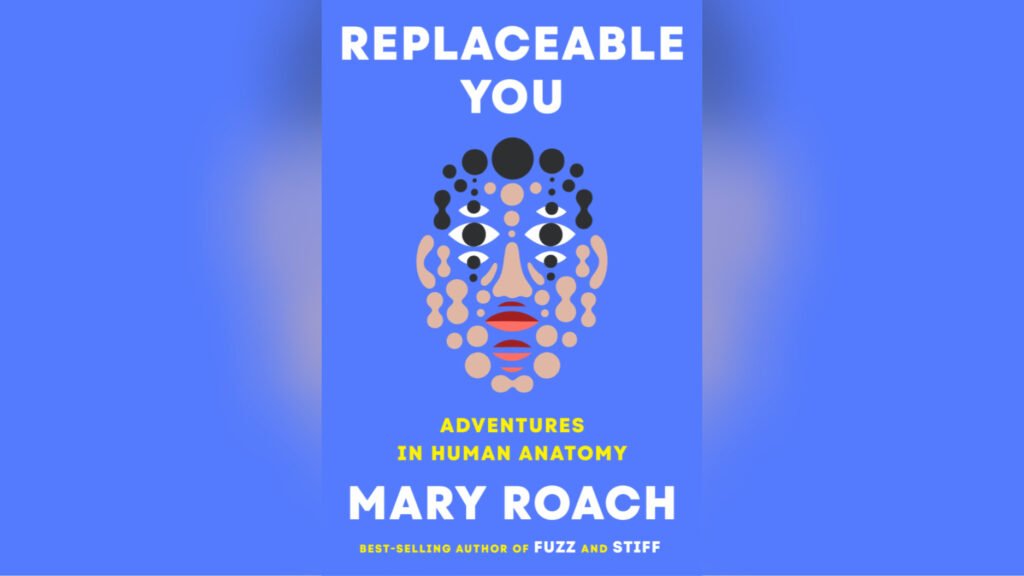“We can rebuild him. We have the technology. We can make him better than he was. Better . . . stronger . . . faster.”
These iconic words were part of the opening lines of the hit TV series, The Six-Million Dollar Man, a show about an astronaut who is severely injured in an experimental aircraft and given bionic implants that turn him into a superhuman secret agent. Back in 1973 when it first aired, the show’s premise seemed a distant fantasy. But like Star Trek‘s tricorders and Lost in Space‘s robot, 1960’s and 70’s science fiction has become much more science fact over 50 years, and prosthetics today are a common sight.
But like just about every medical product, the journey to replacement body parts has been anything but dull. This crazy adventure, and the road still ahead, is the subject of Mary Roach’s latest book, Replaceable You. In her characteristic riveting, accessible, and slightly irreverent writing style that she has become known for, Roach covers, quite literally, from head to toe, the various research that has gone into replacing one’s broken body parts with synthetics, animal parts, and even parts from elsewhere on their own body. And while one might associate such medical products as a solution to improve the health of patients, Roach even explores the innovations for more cosmetic purposes, for when patients want certain things to look bigger and fuller.
Mary was kind enough to chat with us about the inspiration for her latest book and what she thinks the future of replacement body parts might look like:

Scott Jung, GizmoMD: You’ve written on a wide range of subjects, from nature to the afterlife to the military. What led you to focus on regenerative medicine as the subject of your next book?
Mary Roach: Well, for one thing, I’m getting older, so, you know, everything’s gonna wear out soon! But I think one thing was a conversation with a reader who had gotten in touch with me who happened to be an amputee. But she wasn’t just an amputee, but an elective amputee, meaning her foot was technically healthy and had a blood supply. But it didn’t function well partially because she also had spina bifida. So she would see people with a prosthetic lower limb hiking, running, and getting along just fine, and she wondered why she couldn’t have that. So she basically had someone cut off her foot!
GizmoMD: In Replaceable You, you explore ongoing research into autografts, allografts, xenografts, synthetic prosthetics, and bioprinted or lab-grown replacements. Looking ahead, which of these approaches do you think will become the most widely used for human “replacement parts” over the next 50 years?
Mary Roach: I think that the work going on with stem cells, specifically for patient care, has a lot of research underway. You take a patient’s blood cells or skin cells, and you can regress it to pluripotency, where all of our cells started out. And then you can instruct them to become something that they need. For example, you could instruct them to become neurons that produce dopamine that you could then give a Parkinson’s patient. It’s not giving them an organ, but a cluster of cells that could produce a substance that they lack. And the moonshot that everyone’s aiming for is “stealth” pluripotent cells, which are essentially like off-the-shelf pluripotent stems cells that wouldn’t require a patient’s own cells to regress and reprogram.
I also think that bioprinting is really interesting. But it’s really challenging when you think about an organ with multiple types of tissues. So you’ve got to have all these different extruder heads each printing a different kind of tissue. And each tissue has different properties; printing collagen, for example, isn’t a liquid, so you have to liquefy it first and then get it to reassemble itself. And as you’re printing layer by layer, the tissues can be wiggly, so you need to support it somehow. And then you have to think about how and what to feed this living construct, and even how to align the cells structurally for the organ to function properly. It’s still a few decades away, but for somebody who works in medical science, that’s really fast. And still during those years, there will be things that fail and other ideas that come around that no one thought of. It makes it difficult and almost silly to predict the future, because medical technology is changing fast, but always moving slow. But it’s all progress, and it’s all incredibly exciting!
GizmoMD: One of the memorable stories in Replaceable You is your visit to the Amputee Coalition National Conference, where you noted the lack of high-tech, “cyborg-like” prosthetics and the surprisingly lukewarm reception they received. Beyond prosthetics, what other examples did you come across where simpler, low-tech medical solutions worked out better than more advanced technologies?
Mary Roach: In Mongolia, I got to visit Orbis International’s flying eye hospital. Over there, they weren’t doing phacoemulsification, which is when you use sound waves to break up a cataract. Out in the more rural parts of the country, they don’t have the money for a phacoemulsification unit, so they’re teaching the local doctors and surgeons to do a technique with the equipment that they have, which is small incision cataract surgery. And it works! It doesn’t require stitches, so it’s good for the herders and nomadic people in the region. It’s easy to teach, there are fewer complications when taught properly, and so the number of people you can help is far greater.
As for the cyborg prosthetics, I certainly don’t mean to diss the technology. It’s very cool what’s going on, but I think there’s a bit of a gap between some of the hype that’s put out, probably, to get investors. And even though I didn’t see anybody wearing one at the Amputee Coalition Conference, I am sure that they are going to improve over time. Right now, they’re heavy, and they’re mentally a little exhausting to use, but things get lighter, things get better batteries, and things get more waterproof, and that’ll be the progression of these new arms. So I definitely have no doubt that it’s a matter of when rather than if. That barrier to adoption just needs to be lowered and the technology perfected a little bit better, and then these will be more common.
GizmoMD: As you point out, many medical projects fail—not just because of technical challenges or lack of funding, but sometimes because a lead researcher passes away and takes their knowledge with them. From your perspective, what needs to happen to help medical technology advance more consistently and avoid those kinds of setbacks?
Mary Roach: That’s a difficult one that unfortunately doesn’t have any kind of standardized process in research. I don’t really have a great answer, but I can certainly see things that shouldn’t be done. For Packing for Mars, I learned a lot about NASA. Because NASA is the U.S. government, every time there’s a new administration, they bring in different personnel to head the agency and different priorities. So you have this scenario where people spend years and years working on, for example, a capsule that people are going ride in to go back to the moon and maybe onto Mars. And then suddenly, there’s no more Constellation program because Obama came in and had different priorities. I just think that’s a terrible and a kind of abusive model for some, and no way to do any kind of science.
To continue my lessons about NASA, I think it’s healthy to have partnerships. For space technology, there’s always a partnership between private enterprise and NASA, a government agency. NASA, especially now, is an enormous, fairly bloated agency they don’t move as fast as they did back in the Apollo and Gemini days. Private agencies tend to move faster, and so NASA has always involved contractors, such as Boeing, McDonnell Douglas, even Playtex with their expertise in stretchy fabrics.
GizmoMD: You conclude the book by reflecting on how even the simplest body part has proven nearly impossible to fully replicate. That said, where do you think we’ve made the most progress so far in recreating parts of the human body? And on the flip side, which areas do you think hold the greatest promise for being rebuilt “better, stronger, faster”?
Mary Roach: I think lens replacement and the eye has come a long way. It’s so reliable and safe now that people are getting both eyes done at once! That wasn’t the case even three years ago. Researchers still haven’t cracked the kind of accommodation, which is automatically focusing from near to far and far to near, which you and I can do instantaneously with a regular lens. But there’s been a lot of interesting approaches, and I’m confident they’ll figure out something.
This isn’t a body part, but I think medical technology is getting better at extending the lifespan of organs for transplant after they’ve left the donor’s body. I think that the system of just putting them on ice and rushing them away with a four to six window is going to seem really primitive very soon. In Replaceable You, I wrote about heart-in-a-box profusion devices, and they’re going to continue to figure out ways to tweak the technology so the heart stays viable much longer, for days, maybe even weeks.
Replaceable You is now available wherever you purchase books!

